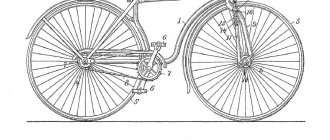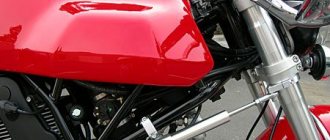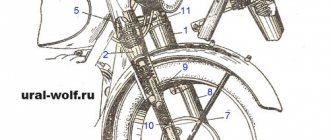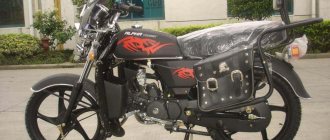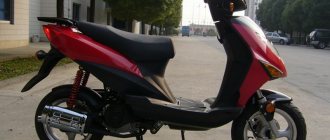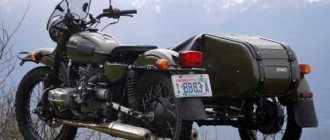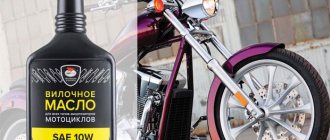What does an inverted front fork give and the advantages of using it?
When buying a motorcycle, it is important to know not only the engine size. Often, when choosing a motorcycle, the buyer does not pay enough attention to what type of front fork is installed on the motorcycle, and this is very important.
So, what are the advantages of inverted front shock absorbers (forks) on a motorcycle:
- Inverted forks have a stiffer design that provides better handling and road feedback. That is, when maneuvering and cornering, the motorcycle obeys commands better, behaves more stable and is less willing to succumb to road unevenness. When turning, especially at speed, you will feel more confident and therefore enjoy the ride more.
— “Shifters” have a more durable design compared to traditional ones. This means that they can withstand greater loads and are more resistant to damage.
— Inverted forks have a reduced unsprung mass, which means they provide better handling of uneven roads and greater comfort compared to a conventional fork. (We recommend studying this topic separately - a very interesting and important effect).
— Another important advantage: as a rule, “reversals” provide the owner with more settings and adjustments, while most conventional forks have no adjustments at all. By customizing the fork to suit your individual needs, you will reap many benefits - from improved comfort to faster cornering speeds and shorter braking distances. After all, the correct operation of shock absorbers to absorb irregularities improves the contact of tires with the road, and therefore reduces the distance required to stop the motorcycle - a big plus for safety.
There is only one downside to such forks - the cost. But when you buy not a fork separately, but the entire motorcycle assembled, then, of course, such a difference is leveled out and that minimal overpayment is definitely worth it.
On small-cubicure motorcycles that do not have a high weight and do not develop high speeds, and the price is one of the key values, shifters are naturally not popular. But on modern motorcycles from 200-250 cc and more, it makes sense to consider options equipped with such an important element; it is for these reasons that similar forks are installed on stock versions of Benelli.
It is not for nothing that inverted forks have long become mandatory on sportbikes and enduro motorcycles, where efficiency, accuracy and durability of the mechanisms are very important at high speeds and loads.
geon.bike
Appearance
In Chinese things, as they usually do, they are used as a basis from first-tier companies, in this case the fork vaguely resembles the FOX 40 with pants, but with the crowns (traverses) there is an incident, for quite a long time I remembered where I could see them and bingo , it's RST Killah! Wow, what a set! 
And the most interesting thing is that the RST and this Chinese have the same thickness of legs - 36mm and crowns (traverses) ...
An anonymous voice behind the scenes: - “Or maybe this is one factory that rivets Chinese Foxes during the night shift?!”
Or maybe, but we don’t know for sure.
In any case, we have this “DIY fork”
kit:
Crowns (traverses) close-up:
In the lower crown (traverse), the one with the steering rod, there are plastic gaskets, it seems to me that their presence is due to the fact that it does not spoil the working surface of the legs.
Anonymous voice-over: - “Pfft, the crown (traverse) is just crooked, and the plastic bushings level out its curvature so as not to spoil the leg.”
By the way, the anodic coating is quite hard and practically not inferior to the forks of the first echelon (in practice, this does not mean that it is similar. It is hard, but not smooth enough, although this does not prevent the fork from sliding in the bushings, but how long the latter will last is a question open).
The pants have a place for attaching a hydraulic line:
Top caps and lids are made very well:
The fit for the caliper (caliper) adapter is not milled, this is bad, for a more accurate fit this should be done:
The rubber bumpers are cast well so as not to damage the frame, there are no complaints about them:
Fork adjustment table for rider weight:
I don’t know who exactly compiled it, but I weigh 93kg in my gear, without thinking twice I pumped up according to the table as for 100kg and... I was only able to move the fork by 10mm. Hmm, very interesting data. I released half the pressure and... again a lot, then I left it at 10 psi and it became more or less, but the sag is only 20mm, and considering that the fork is for DH, AM, FR (as the seller positions it), the sag should be about 40mm. The table is incorrect, you can simply tear off the sticker and throw it away.
Of course, I expected that a model of the fork would come, but in general, if you close your eyes to many things, the fork works, the air swings, the legs in the pants move and don’t bite, the rebound adjustment works... but in general it works strange.
The rebound here is probably intended for Josh Bender:
to land 17m drops on a flat plane, the rebound (rebound) is very dull and thoughtful, from very slow to slow Yes, yes, of course I was “stunned”
Yes, yes, of course I was “stunned”
from such a presentation, but below we will figure out what’s what.
In general, the fork leaves the impression of a very crude product (which, in general, it is), after all the two-crowns that I had, it made me feel sick and sick
, but if it is bought by a person who has never had such forks before, who has ridden all his life on spring-elastomers from Santur, it will seem cool, yes.
In any case, I knew what I was getting into and bought it to have a look and see if it could be made into a workhorse.
Motorcycle fork
MotoVolg » Motorcycle tuning » Motorcycle fork
When BMW specialists developed a telescopic fork with a built-in hydraulic shock absorber in the mid-30s, they hardly imagined that this unit would become an indispensable accessory of any motorcycle.
Diagram of an inverted telescopic fork with separate adjustment of hydraulic compression and rebound force (Motociclismo picture - right).
A modern telescope is lightweight, compact and durable; it simultaneously performs the functions of suspension and steering. This is a plus. Its disadvantages are a direct continuation of its advantages: the limit of universality is the best combination of the worst options.
What is wrong with the traditional telescopic fork? Look at the motorcycle from the side. Do you see this terrible picture: contrasting with the tightly built appearance of the motorcycle is the painfully fragile reed connecting the main mass with the front wheel? Its strength (primarily torsional rigidity) is the main factor influencing the handling of a modern high-speed car. In addition, the reed acts as a lever, multiplying all the braking forces and shocks from road irregularities transmitted to the frame. Therefore, you have to strengthen the unit adjacent to the steering column... and pay the price by increasing its mass.
This is not the only drawback of the telescope. Friction of the pipe-on-pipe type (it is aggravated by the bending action of the fork) leads to an increase in the amount of initial force required to activate the suspension - therefore, the fork does not handle small road irregularities well. The combination of several functions in a compact unit makes it difficult to adjust both the spring preload and the hydraulic compression and rebound forces. And most importantly, when the suspension operates, the geometric parameters of the chassis change, which does not have the best effect on handling.
It would seem that the strength of the front fork can be achieved simply by increasing the diameter of the supporting pipes. But there are pitfalls here. Firstly, the mass of the unit increases - primarily unsprung (which is fraught with a deterioration in the response to road irregularities). Secondly, as the diameter increases, the contact areas increase, and this leads to an increase in the initial actuation force of the fork.
When the solution to the puzzling problem is finally found, exclamations are heard: This is elementary!.. And the specialists from the Dutch company WP came up with an idea: what if you take a fork and turn it over? In a traditional telescopic one, the diameter of the lower sliding pipes to which the wheel is attached is larger than the diameter of the supporting ones. In the design, which immediately received the name upside-down or inverted, everything is the other way around: the supporting pipes are larger in diameter than the sliding pipes
It is difficult to count how many goals were immediately achieved with this ingenious solution. The fork's bending and torsional rigidity has increased sharply, and the unsprung mass has decreased. In a conventional telescope, the fork stroke is limited by the gap between the upper ends of the movable pipes and the lower bridge, its design is free from this limitation, which allows storage of the same stroke length, the pipes go deeper into each other, and this increases the distance between the support bushings and increases the rigidity of the unit.
Nowadays, there are several designs of inverted telescopic forks. Their hydraulic part basically repeats the design adopted for traditional shock absorbers - with a valve system not only in the working piston, but also in the bottom part. Often, only the hydraulic compression force is adjusted on one fork leg, and only the rebound force on the second. Sometimes compensators are introduced into the design to reduce the viscosity of the liquid when heated (such a compensator is a conical needle that, when heated, reduces the cross-section of a calibrated channel).
Ten years ago, when upside-down forks first appeared, they were considered an accessory only for the coolest motorcycles - primarily sports cars for road racing, motocross and enduro competitions. Then European manufacturers began to actively use them and reduce the overall length of the plug in devices for reasons unknown to us; until the last they resisted the introduction of this unit into the series. Only in recent years has there been a breakthrough, and there is no reason to doubt that we will soon see upside-down forks on all Japanese sportbikes. What about extreme sports bikes? They now offer inverted forks for scooters, and even for mere mortals. Japanese concerns, widely using such forks in sports practice, are desecrating shrines! - for cruisers.
THREE OBJECTIVES OF A TELESCOPE
Like any suspension, a motorcycle telescopic fork performs three functions.
- 1 It works as a guide vane, determining the trajectory of the wheel.
- 2 Suspension: it is provided by a spring, and in hydropneumatic forks there is also an air cushion above the surface of the oil.
- 4. Damping of vibrations. For this purpose, a shock-absorbing device is provided - a set of calibrated holes and valves that block them, through which oil passes. Moreover, the design of the valve mechanism is selected in such a way that it provides minimal resistance during compression (otherwise the fork will not handle road unevenness) and several times more resistance during rebound (when the actual damping occurs).
WHAT'S NEXT?
No matter how you improve the telescopic fork, it is impossible to get rid of some of its inherent shortcomings (high internal friction, low rigidity, changes in geometric parameters). In addition, motorcycle manufacturers are irritated by the technological complexity of this unit compared to the compact shock absorber used in rear suspensions. Therefore, it is understandable why a replacement for the telescope is being intensively sought.
The simplest version of an antitelescope has been known for a long time - lever forks, in which the entire supporting structure, as in telescopic ones, rotates around the steering column. Having peaked in popularity in the 50s, they now survive only on older scooters (and some retro Harley-Davidson models). Alas, with all the undoubted advantages (anti-dive geometry of pull-type forks, the use of shock absorbers unified with rear suspension units), the rigidity of such structures leaves much to be desired. Which led to their extinction.
Therefore, in recent decades, designers have turned their attention to lever forks with a fixed trailing arm and a steering knuckle. In such suspensions, the frame can be more compact - due to the elimination of the steering column, the unsprung masses are smaller, the center of gravity is reduced, and a traditional type of shock absorber is acceptable. Motorcycles with similar suspensions were even mass-produced (Yamaha GTSIOOO, Bimota Tesi). But this design also has a sore spot - the gap between the steering wheel and the front wheel. And drivers complain about the inadequacy of feedback - steering feel. This shortcoming actually canceled out all the advantages of the system.
A compromise between it and a traditional telescope can be Telelever - it is used on BMW R and K series motorcycles.
The fixed trailing arm is connected to a telescopic fork. True, its pipes play the role of a guide vane in the system; the functions of suspension and vibration damping are given to the shock absorber connected to the lever. Like any good compromise, Telelever has successfully combined the strengths of both systems. If it weren't for his mass. But for BMW it is forgivable.
motovolg.com
After modifications
The fork looks like this:
On a bike it looks like this:
The inscription " Himalo"
"was carefully cut with a blade using masking tape as cutting guides (cut because the fork has little in common with this manufacturer, and the name does not look nice, but simple graphics, not flashy, look better). The pressure adjustment in the cartridge practically does not stick out, which is a plus, the lid perfectly matched the color palette of the fork, rubber rings were installed on the threaded connections at the bottom of the pants so that oil would not leak out from under the threads. The fork is ready to be installed on the bike.
Always in touch. The design of the front suspension and steering of a motorcycle.
Text: Artem 'S1LvER' Terekhov
Don't think, this is not a story about a popular social network. Let's leave such articles to glamorous magazines and move on to more interesting things. Namely, let's talk about the front suspension, as well as the related element of the bike's design - the steering.
The main tasks of the suspension are to absorb road irregularities while constantly maintaining contact of the wheels with the road. For these purposes, you need to take something that can compress and stretch - a spring is ideal for our needs. However, using only springs, without additional devices, would lead to a very uncomfortable ride. To control vibrations, you will need some way of damping them, the best medium for this may be oil.
In general, the oil-spring combination is the most popular when designing front suspension. The question is how to position it all in conjunction with the steering. Motorcycle manufacturers have tried various designs: telescopic forks, push-pull linkage forks, automotive-type linkage suspension and parallelogram forks (for example, the three-wheeled Piaggio MP3).
The steering scheme on all motorcycles is very similar - bikes “inherited” this mechanism from bicycles. There is not much to say about it - it is a pipe connected to the front wheel, which rotates relative to the frame. The differences in design are due to differences in the suspension pattern - but in any case, the principle remains the same.
Unsprung masses are the most important masses in the world
What is it, and why do manufacturers perform ritual dances every time they “managed to reduce the unsprung masses by as much as 50 grams”? The fact is that the mass of all motorcycle components is globally divided into two categories. The first is the mass of components supported by the suspension (“sprung masses”). This includes everything that is affected by the effect of the suspension - the engine, frame, plastic, turn signal bulbs, horn button - in general, everything that is supported by the suspension. The mass of the remaining components, those that do not rely on the suspension, is called “unsprung”.
To make it easier to understand the concept of unsprung masses, imagine a motorcycle removed from the stand and positioned vertically. When the rider gets on the motorcycle, the springs are compressed under the load of his weight. All motorcycle components that move when the driver sits down and the springs are compressed are sprung masses; they move along with the suspension. All other components that do not move are unsprung masses - wheels, tires, brakes, etc.
Everything you see in this frame refers to the unsprung mass of the motorcycle
Then the question probably popped up in your mind: where should the pendant itself be taken in this case? For simplicity, it is generally accepted that the part of the suspension arm (we are talking about the rear suspension now), located behind the shock absorber mounting point, refers to the unsprung masses, and the part that is located in front of the mounting point refers to the sprung masses. The lower half of the shock absorber is unsprung, the upper half is sprung. In the case of the front suspension, the moving part refers to the unsprung masses, and the stationary part refers to the sprung masses.
Why is all this getting so much attention? We'll have to delve a little into physics. When the motorcycle hits a bump, the unsprung masses gain momentum as they begin to move. The magnitude of this impulse is proportional to the unsprung mass. The impulse created by unsprung components increases the load on the suspension, and stiffer springs are needed to counteract it. At the same time, greater force is transmitted to the sprung components of the bike by the springs, which affects their operation. A similar situation occurs when unsprung components fall into a pothole.
Another important aspect when it comes to mass is the moment of inertia that occurs when the rider wants to turn the bike. The greater the unsprung mass, the more the motorcycle “thinks and resists” before it deigns to lean into a turn.
Therefore, for the suspension to work ideally on all sides, it is necessary that there are no unsprung masses at all, but this is unrealistic. The point is to make the unsprung elements as light as possible in relation to the sprung ones - this ratio is even more important than the amount of unsprung mass itself.
Based on this ratio, the Honda GoldWing looks like a very good bike. It has a very large mass of sprung units, much more than on many motorcycles. At the same time, the unsprung masses are approximately the same as those of other motorcycles. However, on sports bikes they try to keep weight to a minimum, so all the techniques that can be used in mass production are used: installing lightweight brake calipers, forged aluminum rims, which are lighter than cast ones. If a competitive price is not a priority, go all out: lightweight monoblock calipers, wheels made of magnesium alloy or carbon fiber. In the world of unsprung masses, a few tens of grams of savings is already a victory, and if the count is hundreds of grams, engineers rejoice like little children.
The unsprung masses may not be the smallest in the world, but their ratio to the sprung masses of the bike is good. Honda Gold Wing
Telescopic fork – the choice of millions
This fork is the most commonly used front suspension design, which is easy to notice when looking at modern production motorcycles. It consists of two fork legs clamped into cross members, which are part of the steering. The wheel axle passes through the bottom of both fork legs, and the wheel is located between them.
With a standard fork, the upper (fixed) pipes are clamped in the cross-members. The lower (moving) fork tube is tightly installed on the fixed pipe, which is cast from light alloys in order to reduce NM. Inside each rack there is a spring, due to which the movable pipe moves along the stationary one.
The fixed part of the fork is clamped in two crossbars. Kawasaki Ninja ZX-6R 2008
As a front suspension, the “telescope” copes well with its duties. It provides sufficient suspension travel and relatively low NM. The main drawback is the low rigidity - the fork has a fair amount of flex that is only useful in small amounts. To increase rigidity, an additional traverse is often used.
A very important condition for the high-quality operation of any fork is the friction between its pipes. Nowadays, on most forks, replaceable bushings made of low-friction material containing Teflon are installed between the two pipes to reduce static friction (the initial resistance between the parts before they begin to move). In addition, manufacturers use (and do not forget to teach this as a cool “feature” of a motorcycle) various anti-friction coatings for the moving parts of the fork.
Nowadays, traditional forks are increasingly being replaced by “reversals”. In principle, this is a standard fork turned upside down so that the large diameter pipe, which was previously movable, becomes stationary and clamped in the traverses, and the inner pipe, which was previously stationary, is located below. Inverted forks are stiffer than traditional forks, and there is also some benefit in reducing unsprung mass. Moving tubes coated with titanium nitride are quite typical on sports and motocross motorcycles today.
Moped and scooter forks are simpler than those found on motorcycles - cost is a major factor here. Due to lower speeds, a simple suspension is sufficient. Scooters are often equipped with a simplified telescopic fork, in which the two upper pipes, assembled with the lower crossmember and the steering column pipe, form a single structure.
Gilera Runner scooter fork
A few words about springs
Ideally, a progressive characteristic or increasing stiffness is desired, that is, with small impacts the fork should move easily, and as the fork is further compressed, the resistance to movement should constantly increase so that large impacts do not cause the fork to break through.
In the simplest springs, the coils are wound evenly (the distance between them is the same), which gives the spring constant stiffness. These are the simplest and most inexpensive springs to manufacture.
Spring with constant winding pitch
Sometimes manufacturers combine two springs of different constant pitch springs, placing them one above the other. The first spring compresses easily and serves to absorb small bumps and shocks, providing a fairly smooth ride. As the impacts intensify, nearby branches of the first spring meet each other and form a solid rod. After this, a second, stiffer spring comes into action, which copes with the long-term absorption of large irregularities. This scheme slightly increases the cost of the suspension, although it is still simple to manufacture.
An alternative is to use a single spring, wound in such a way that the pitch of its coils gradually increases from one end to the other - this provides a progressive suspension characteristic. The price for improved comfort and normal operation on roads of varying quality is high cost and labor-intensive production.
Variable pitch springs for progressive response
Damping
When the bike hits a “feature” on the road, the impact energy is absorbed by the springs. Naturally, the spring immediately strives to transfer this energy to the sprung masses (SM) of the car. Shock absorption, or damping, is the control of the spring's response rate. The lack of shock absorption would mean the bike would bounce happily when going over several bumps in a row.
The standard oil damping device is based on a valve or hole of a certain diameter in the bottom of the fork tube filled with oil. As the movable pipe moves upward, oil is forced to flow out through the valve or drilling into the pipe. When the pipe moves down, the oil resists the movement of the suspension. This prevents the springs from trying to “rock this world” on the scale of a single bike.
For rider comfort, it is best if the wheel can move freely, reacting to uneven surfaces. However, engineers have to think about more than just comfort - a damping effect is needed to improve handling. In addition, the degree of damping should depend on the rate of compression and expansion of the fork - therefore, there is far more than one valve in the fork; different holes are used. When a certain maximum oil pressure is reached due to a high compression or expansion rate (large potholes on our roads are at your service), additional valves are used. Shock absorption is achieved through the use of a piston shock absorber or a cartridge damper - both are bolted to the base of the fork's travel tube and located in the oil cavity.
Now let's talk in more detail about each scheme.
The most commonly used fork is a piston shock absorber. The piston is a tube with holes located in the oil. In the upper part, the cross-section of the piston is larger; there is an o-ring on it, which rests on the inner wall of the fork tube. As the fork tube moves up or down, the shock piston forces oil to flow through various holes. At the base of the fork tube there is a check valve that allows oil to flow when the fork is compressed, and when stretched it closes and prevents overflow. This achieves the necessary damping characteristics to provide comfort when the fork is compressed and control when extended.
The principle of operation of a cartridge-type fork is also based on the flow of oil through throttling valves, but the cartridge damper is distinguished by the presence of many holes at the end of the piston rod. The rod extends from the cartridge and is attached to the top of the fork so that when the fork is compressed or extended, the piston can move inside the cartridge. Compression damping valves are located at the base of the cartridge. Rebound damping valves (extension rebound) are located on the piston. When the forks are compressed, the rebound valves close and the piston forces oil through the compression valves. When the fork is stretched, the rebound valves open and let in oil.
Suzuki GSX-R750 2004 fork section, tuning kit from Axxion
The valves consist of low-speed and high-speed oil passages (when we talk about suspension, we mean the compression-extension rate, not the speed of the motorcycle). Low-speed channels can have a fixed cross-section - therefore, provide damping with a constant resistance, or be adjustable. Such channels are designed to absorb small road irregularities. Medium and high speed oil passages begin to operate as pressure increases due to increased travel speed. They are designed to absorb large uneven surfaces. Medium and high speed movement is controlled by a stack of plates of varying diameters and thicknesses stacked on top of each other to cover the holes through which the oil passes. At an average speed of movement caused by slight unevenness in the road, a thin plate of large diameter easily bends under the pressure of the liquid and ensures its flow, but the amount of deflection is limited by plates of greater thickness and smaller diameter. Moving at high speed (for example, when the bike hits a track curb or a wheel falls into a pothole) will create additional pressure, causing smaller diameter and thicker plates to bend and increasing the volume of oil passing through the holes.
Fine-tuning a cartridge-type “telescope” involves selecting the number and diameter of holes in the piston and the number and size of plates. On racing bikes, adjusting such a fork is much easier, since the conditions and loads are known in advance and do not have a very wide range.
By the way, Alexey from our friendly site moto.swissblog.ru recently wrote an excellent article about suspension settings. We recommend it to those who are interested not only in the theoretical side, but also looking for practical advice on this issue.
What's better?
A cartridge fork provides better damping performance than a piston shock absorber - mainly because the compression and rebound processes are separated by the use of different valves. Another advantage of the “cartridge” is that its operation is not affected by air bubbles that enter the oil when the fork is compressed and stretched. Simply because they do not get into the mechanism, as happens in piston shock absorbers. The main disadvantage of the “cartridge” is increased wear - the inner surface of the aluminum outer tube is anodized to prevent wear when the inner tube bushings move along it. But the anodized surface does not have a smooth structure, so it wears out the bushing, tearing off Teflon particles from it, which then get into the oil.
In cartridge forks, the oil flow rate is very high, so the performance of the fork is highly dependent on changes in the properties of the shock-absorbing fluid. As it becomes dirty, the wear rate increases and the likelihood of various particles getting into the plate packs increases. Here, each manufacturer gets out as best it can: for example, Yamaha on its R1 installs bushings in the outer pipe so that the inner pipes coated with chrome move along them, and not the outer pipes made of anodized aluminum.
Big piston in action
The latest development in the field of telescopic forks is the Big Piston Fork technology from the Japanese from Showa. The volume of oil in such a fork is larger, the pressure is correspondingly lower, which means a lower speed of oil movement. This has the best effect on low-speed damping, in other words, under heavy braking the bike is less prone to nose dive. In addition, simplification of the design makes the fork lighter and reduces NM.
Section of BPF fork Kawasaki ZX-6R 2009
The “big piston” debuted on the 2009 Kawasaki ZX-6R and immediately received a lot of rave reviews in the press - almost every journalist was in a hurry to report better front wheel control and clearer and smoother suspension operation. Since 2010, the big brother of the 600 cc Ninja, the ZX10R, has also been equipped with BPF.
Comparison of cartridge plug and BPF plug. Parts that were eliminated using the Big Piston technology are marked in orange.
****
We have figured out the structure of a telescopic fork - the most common front suspension design in the motorcycle world. Next time we’ll leave all the exotic stuff: anti-dive systems, lever (in particular, the Bimota Tesi 3D mechanism), pneumatic and parallelogram forks. In addition, we’ll figure out what some of the bike’s geometric parameters mean and how they affect handling. See you later!
motocafe.ru
Characteristics
Stem/crowns (traverses)
1.1/8 in.
On the upper crown (traverse) there is a Direct mount for the stem.
Left leg
Air pumping on top - Solo Air, negative coil spring + rubber damper.
Right leg
Closed oil damper with 170mm stroke, with rebound adjustment (we will see later that the damper has a longer stroke).
Both legs are made of aluminum and have a black anodized coating and a diameter of 36mm.
Trousers
It is possible to install a wheel up to 29 inches, an axle 110*20, very thick brutal dropouts. Inside the bushings there is metal/polymer, everything is the same as in the older brothers (this point is important, as it affects the wear of the leg covering and the performance of the fork as a whole)
Fastening the caliper (caliper) Post Mount.
Magnesium alloy pants.
Motorcycle fork
When BMW specialists developed a telescopic fork with a built-in hydraulic shock absorber in the mid-30s, they hardly imagined that this unit would become an indispensable accessory of any motorcycle.
A modern telescope is lightweight, compact and durable; it simultaneously performs the functions of suspension and steering. This is a plus. Its disadvantages are a direct continuation of its advantages: the limit of universality is the best combination of the worst options.
What is wrong with the traditional telescopic fork? Look at the motorcycle from the side. Do you see this terrible picture: contrasting with the tightly built appearance of the motorcycle is the painfully fragile reed connecting the main mass with the front wheel? Its strength (primarily torsional rigidity) is the main factor influencing the handling of a modern high-speed car. In addition, the reed acts as a lever, multiplying all the braking forces and shocks from road irregularities transmitted to the frame. Therefore, you have to strengthen the unit adjacent to the steering column... and pay the price by increasing its mass.
This is not the only drawback of the telescope. Friction of the pipe-on-pipe type (it is aggravated by the bending action of the fork) leads to an increase in the amount of initial force required to activate the suspension - therefore, the fork does not handle small road irregularities well. The combination of several functions in a compact unit makes it difficult to adjust both the spring preload and the hydraulic compression and rebound forces. And most importantly, when the suspension operates, the geometric parameters of the chassis change, which does not have the best effect on handling.
It would seem that the strength of the front fork can be achieved simply by increasing the diameter of the supporting pipes. But there are pitfalls here. Firstly, the mass of the unit increases - primarily unsprung (which is fraught with a deterioration in the response to road irregularities). Secondly, as the diameter increases, the contact areas increase, and this leads to an increase in the initial actuation force of the fork.
When the solution to the puzzling problem is finally found, exclamations are heard: This is elementary!.. And the specialists from the Dutch company WP came up with an idea: what if you take a fork and turn it over? In a traditional telescopic one, the diameter of the lower sliding pipes to which the wheel is attached is larger than the diameter of the supporting ones. In the design, which immediately received the name upside-down or inverted, everything is the other way around: the supporting pipes are larger in diameter than the sliding pipes
It is difficult to count how many goals were immediately achieved with this ingenious solution. The fork's bending and torsional rigidity has increased sharply, and the unsprung mass has decreased. In a conventional telescope, the fork stroke is limited by the gap between the upper ends of the movable pipes and the lower bridge, its design is free from this limitation, which allows storage of the same stroke length, the pipes go deeper into each other, and this increases the distance between the support bushings and increases the rigidity of the unit.
Nowadays, there are several designs of inverted telescopic forks. Their hydraulic part basically repeats the design adopted for traditional shock absorbers - with a valve system not only in the working piston, but also in the bottom part. Often, only the hydraulic compression force is adjusted on one fork leg, and only the rebound force on the second. Sometimes compensators are introduced into the design to reduce the viscosity of the liquid when heated (such a compensator is a conical needle that, when heated, reduces the cross-section of a calibrated channel).
Ten years ago, when upside-down forks first appeared, they were considered an accessory only for the coolest motorcycles - primarily sports cars for road racing, motocross and enduro competitions. Then European manufacturers began to actively use them and reduce the overall length of the plug in devices for reasons unknown to us; until the last they resisted the introduction of this unit into the series. Only in recent years has there been a breakthrough, and there is no reason to doubt that we will soon see upside-down forks on all Japanese sportbikes. What about extreme sports bikes? They now offer inverted forks for scooters, and even for mere mortals. Japanese concerns, widely using such forks in sports practice, are desecrating shrines! - for cruisers.
Three tasks of a telescope
Like any suspension, a motorcycle telescopic fork performs three functions.
- It works as a guide vane, determining the trajectory of the wheel.
- Suspension: it is provided by a spring, and in hydropneumatic forks there is also an air cushion above the surface of the oil.
- Damping vibrations. For this purpose, a shock-absorbing device is provided - a set of calibrated holes and valves that block them, through which oil passes. Moreover, the design of the valve mechanism is selected in such a way that it provides minimal resistance during compression (otherwise the fork will not handle road unevenness) and several times more resistance during rebound (when the actual damping occurs).
What's next?
No matter how you improve the telescopic fork, it is impossible to get rid of some of its inherent shortcomings (high internal friction, low rigidity, changes in geometric parameters). In addition, motorcycle manufacturers are irritated by the technological complexity of this unit compared to the compact shock absorber used in rear suspensions. Therefore, it is understandable why a replacement for the telescope is being intensively sought.
The simplest version of an antitelescope has been known for a long time - lever forks, in which the entire supporting structure, as in telescopic ones, rotates around the steering column. Having peaked in popularity in the 50s, they now survive only on older scooters (and some retro Harley-Davidson models). Alas, with all the undoubted advantages (anti-dive geometry of pull-type forks, the use of shock absorbers unified with rear suspension units), the rigidity of such structures leaves much to be desired. Which led to their extinction.
Therefore, in recent decades, designers have turned their attention to lever forks with a fixed trailing arm and a steering knuckle. In such suspensions, the frame can be more compact - due to the elimination of the steering column, the unsprung masses are smaller, the center of gravity is reduced, and a traditional type of shock absorber is acceptable. Motorcycles with similar suspensions were even mass-produced (Yamaha GTSIOOO, Bimota Tesi). But this design also has a sore spot - the gap between the steering wheel and the front wheel. And drivers complain about the inadequacy of feedback - steering feel. This shortcoming actually canceled out all the advantages of the system.
A compromise between it and a traditional telescope can be Telelever - it is used on BMW R and K series motorcycles.
The fixed trailing arm is connected to a telescopic fork. True, its pipes play the role of a guide vane in the system; the functions of suspension and vibration damping are given to the shock absorber connected to the lever. Like any good compromise, Telelever has successfully combined the strengths of both systems. If it weren't for his mass. But for BMW it is forgivable.
spasiboauto.ru
Preface
Over my long extreme career (18 years), I have ridden quite a few forks (talking about those that were in my control, those that I chewed and tried do not count): List
- Acceptable sure bets
- SR Suntour Duro
- SR Suntour Duro FR
- Marzocchi Junior T
- Marzocchi Super T
- Marzocchi 55R (with drilled cartridge 2008)
- Marzocchi 66ATA
- DNM Volcano coil
Normal forks
It is clear that I was thrown to different extremes and wanted to try both simple and flip-flops. And after everything was on sale, I picked up and settled on Marzocchi Drop Off II, it has everything I love, it’s plushness
, air pumping, compression, rebound (rebound) in general a good thing, and from the list as a whole you can highlight that the soul always lay with Marzocci.
And in general, I have some experience, all my forks were serviced independently, everything always worked like clockwork and is now working for the new owners. But I always wanted to see what kind of double-crowns from China they were. I came across this model by accident, bookmarked it about a year ago, and started watching the reviews. In general, the store has a lot of reviews and they write different things, but there is almost nothing about this model, which made me very sad.
But one day in one of the VK public pages I saw how a person posted a photo about a Chinese man, and it was exactly the same as this example. I contacted him and started asking for detailed pictures, started asking what and how. He told me about the nuances that interested me (bushings/pants/thickness of legs/covering) and told me how he finalizes it.
And since I’m a person who likes to improve everything, I couldn’t resist, but there’s a whole field for bringing it back to normal! I started talking to the seller about sending it for review, but it didn’t work out very well, the seller simply ignored my requests and I had to buy it.
Proof of purchase:
And in order to fill the gap about the missing materials, we will subject it to total disassembly and modification.
For clarity and understanding of what follows, I’ll show you this picture so that everyone can understand what we’re talking about.
Testing
Well, what you’ve all been waiting for a long time, namely action!
Let's go for a ride. Before the video of the work, I will first show how the fork coped with the baptism of fire. Namely, when I was skating in a skate park, at the exit from the quarter my wheel blew off, and I grinded the fork’s foot along the metal edge of the quarter, I thought that was it, the end of the anode, but the anode survived only with a slight dent:
It is located in the upper part of the working stroke, so it is not critical. You can hardly feel it with your finger, as if it was slightly matted with sandpaper, I think you can polish it with a zero or even hammer it in, the fork is Chinese 
Since the tracks have not yet dried, and rolling and destroying them when they are wet is bad manners (you’ll have to fix them yourself later), I’ll show you my everyday route to work, small drops, forest marches, I think it will be enough to evaluate.
Current settings: 1. left leg with air spring - 120 PSI, 2. right leg - 200 PSI in cartridge, 3. rebound set to medium.
Meter-long drop into the flat and flight of stairs:
Hills and a long flight of stairs in 3 flights:
